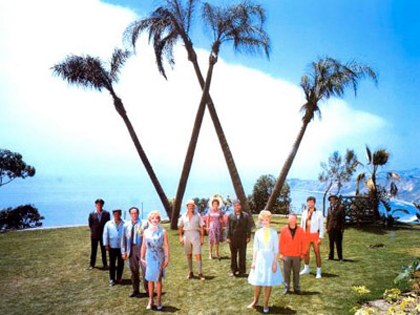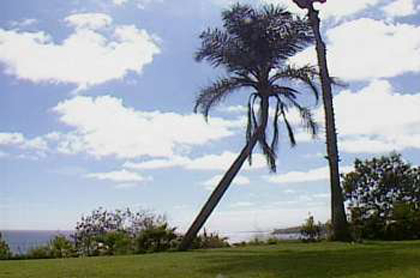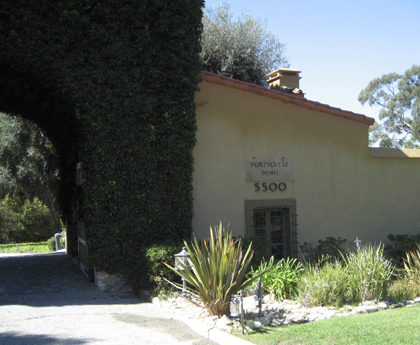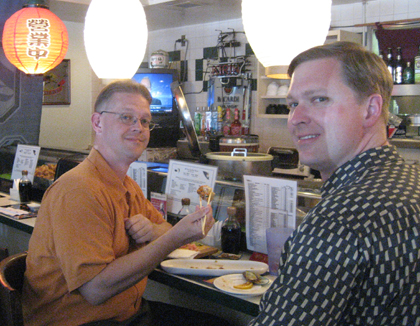 After the long, busy, and incredible day I had experienced on Monday, it felt good to sleep in a bit and spend a nice leisurely morning relaxing at Jimmy’s house when I got up on Tuesday, October 7. Cassidy had sent home some of the leftover pizza from the party at her place on Sunday and I had the leftover Olive Garden to snack on in the morning. And of course, there was the traditional giant carton of Goldfish crackers which hit the spot while watching some more reruns of It’s Your Move. And naturally, as any good road trip must be preceded by, there was the cermonial reading aloud of the hilarious pamphlet So What About Fin?
After the long, busy, and incredible day I had experienced on Monday, it felt good to sleep in a bit and spend a nice leisurely morning relaxing at Jimmy’s house when I got up on Tuesday, October 7. Cassidy had sent home some of the leftover pizza from the party at her place on Sunday and I had the leftover Olive Garden to snack on in the morning. And of course, there was the traditional giant carton of Goldfish crackers which hit the spot while watching some more reruns of It’s Your Move. And naturally, as any good road trip must be preceded by, there was the cermonial reading aloud of the hilarious pamphlet So What About Fin?

The traditional reading of the masterpiece
We finally got our butts in gear and headed out just before 11am to our first stop of the morning. Jimmy and I had long talked about trying to make a visit to the Big W site from the classic extravaganza film It’s a Mad, Mad, Mad, Mad World. For those who have not actually seen the movie, the plot revolves around total strangers in a treasure hunt to find a wad of buried money under the ‘Big W’ palm trees at a mythical location called the Santa Rosita Beach State Park. The site was actually located in Rancho Palos Verdes, which is in the southernmost part of Los Angeles County. None of the Wileys had ever been there so we weren’t sure exactly what we were looking for…but knew that it did reside on private property.
It was less than a half-hour away from Jimmy’s place in San Pedro, and when we arrived at the park known as Portuguese Point, we didn’t know exactly how to approach finding what was left of the Big W. One of our friends Earl Kress had visited the location in the 1970’s at which point it was a ‘Big VI’. As the palm trees forming the Big W began to die and collapse, it became the Big V and eventually the Big I. This was how it stood as of the last report in the documentary Something a Little Less Serious, a 1991 documentary about the film.
So although it was rather hot out, Jimmy and I decided to take a hike down the beach to get the closest view possible of the area. It was a good 25 minute walk by the time we climbed down the hill through rattlesnake territory to the beach area and then trudged up the slope at the rear of the property, stopping along the way so that I could wade in the water. You see, this also marked the first time that I had ever stepped into the Pacific Ocean. So no matter how this turned out, I was able to accomplish something new.

I was even willing to brave the rattlesnakes to find the Big W

No matter what happened, it was certainly a most lovely view

First steps into the Pacific ocean
So did we see what was left of the Big W? I wish I could give you a conclusive answer. I could find nothing on the internet to indicate any follow-up to the saga of the Big W since its documentary appearance in 1991. What we did in fact see was a palm tree of some age (it was tall) that appeared to be sloping in the same direction as the one seen in the doc. If this wasn’t the tree, then the tree no longer stands – because this was most certainly the tree cluster that is now standing on the Big W’s location. Logic tells me that the tree probably has not survived. If three trees had fallen within the first 30 years, then mostly likely the fourth one had died within 45 years.

The Big W as seen in It’s a Mad, Mad, Mad, Mad World

The final tree as seen in the 1991 documentary (taken facing the ocean as in the photo above)

The area in 2008, as seen from the opposite side

If that’s not the tree, it’s funny that it is sloping in the same direction as the last Big W tree
After photographing a posing with the Big W area, we climbed the rest of the hill and ended up back on the road. From there we passed in front of the entrance to the park, which incidentally can also be seen briefly in the film as the treasure-hunters enter the park. We got back to the car around noon and headed back to Jimmy’s place in San Pedro.

To give you a point of reference, we parked by the building and parking lot seen top left, walked down the hill to the ocean, back up the hill, stopped at the rear of the cluster of palm trees (which is where the Big W stood), and then took this photo as we climbed the opposite side of the hill toward the road

The entrance to the park which is seen in the film as well. If we had had the guts, we could have simply walked through that gate, onto the private property, and stood in front of the Big W area
There we changed clothes and headed out for our next adventure of the day. But first, I talked Jimmy into eating at the local sushi bar Sushi 21. Bob and I had had lunch here when I was in California the previous Summer. Jimmy had never been here, and I think he rather enjoyed it. I took one last chance to fill up on the all-you-can-eat (in one hour) array of specialty rolls, stuffing myself to the brim. It made our next event a little uncomfortable, but hey…that’s the price you pay (in addition to the $24.95).

The reward for a hard morning’s expedition
The day in California will continue…
In 1965, the popular local radio station had a contest to find the missing “W” from the call-letters “WONE”. They went so far as to remove the “W” from the display sign on the studio building. It seems to me that the missing letter was the first letter of a street name on a nearby street sign, but I could be wrong on this. It was a very popular contest around Dayton, probably derived from “It’s a Mad, Mad, Mad, Mad World”.
Dad
January 10th, 2009
Hi, Brad–I’ll ask Rob about the Big W tree, as he’s been to that location many times. Please e-mail me and tell me about that “What About Fin?” book. The guy who wrote it has several other L&H-themed books (pamphlets?) and I’d like to know if there’s anything of value in ’em.
Randy Skretvedt
January 12th, 2009
From what I was told by a former co-worker at CBS who lived in the area,they were cut down in order to keep lookie loos from coming into that area.
The Palos Verdes/Rolling Hills area likes to keep strangers out and the “W” became a gathering point for people at one point.I spend a lot of time in San Pedro since i live in the area,too!
Raul Moreno
January 17th, 2009
I too was in that locale in 1993. I took a picture of the property from a nature trail just south of the property and took a picture that looks a lot like the same point of view as the third picture from the bottom. I saw the last remaining tree of the Big W, and it appears in the photograph I have….I’ve been meaning to get the picture scanned. If I could go back to that time, I would have been more adventurous and climbed up to it from the beach. From the pictures I see here, it appears that the last tree is gone, unfortunately.
Eric
July 7th, 2010
I live there (1984-2011). We have a lot of palm trees there that are overgrown but I am pretty sure we still have the one last palm but I think it is half dead and really slanted. It is a good thing you didnt walk in the gates, we have guard dogs and you would have to deal with me yelling at you.
Kelly
February 17th, 2011
Kelly, would you be willing to take a picture of the tree that you think is the last one of the Big W and post it?
Eric
September 15th, 2011
Awesome post! I love Portuguese Point and the Big W location. By the way, the slanted tree in your photos was in the movie, although not as part of the Big W. It was one of the trees off to the left of the W, and can be seen as the semi-large tree in the background that is closest to the edge of the property as they throw Phil Silvers into the hole. The last tree of the Big W died in 2005 or thereabouts, and stood until about early 2008, when it fell down and was cut up. The cluster of palm trees mentioned is actually about 40 feet south of the Big W location.
Price
January 23rd, 2012
Hi!! I’m from Spain and I’ve long time to find the big W photos, but not the movie pics, other photographs, somebody have some pics?? I’m traveled to LA four years ago and I saw the location in Portuguese Point! Thaks a lot!!! My e-mail is moreno711985@gmail.com Bye!!
Cherry
May 2nd, 2012
Good luck Cherry!
Peter
May 2nd, 2012
Thank you Peter!
Cherry
May 2nd, 2012
Hi, We are fans of Mad Mad World and the Big W. Can the public wander into Portugese Point Park to see what’s left of the big W? Thanks!
Brian & Joyce in Northern California
Brian Granville
June 11th, 2013
Dear Sir,
The most prominent leaning tree in your picture from 2008 is a Mexican fan palm, Washingtonia robusta. The trees of the ‘W’ and in the documentary picture are queen palms, Arecastrum romanzoffianum. To the right of the ‘W’, there is a Mexican fan palm. It is small in the movie, but much taller in the documentary picture. There is a queen palm in your picture as well. It is to the left and seems to be in front of the other trees; but also seems to have a straight trunk. (A smaller specimen is to the right.) Until I found your page, I never realized how silly those trees looked in the movie. They were obviously just placed there for the movie, which is why their trunks are so straight. In the documentary picture, you can see how the trunk kinked and grew vertically after it had been placed in the unnatural position. (Like almost all plants, queen palms grow away from gravity and toward sunlight.)Palms that lean naturally (as if they are trying to grow out from under the shade of larger trees) will develop a curved trunk as they reach sunlight, but rarely kink sharply. However, the kinked Mexican fan palm in your picture looks suspicious. It could be natural, but seems to be the result of sudden displacement, as if the tree was pushed over, or even planted at an angle like the ‘W’ trees were. The kink would be about the same age, since Mexican fan palms grow faster than those old fashioned queen palms grow. (Modern queen palms grow faster than old ones.)This is probably way too much information about palms, and way to many parenthesis; but I find your pictures and information about these historical trees to be quite fascinating.
Tony Tomeo
January 30th, 2016
As a young adult, I worked for a magazine company, where we traveled across country selling magazine subscriptions; it took me nearly two years to visit forty states (Plus one day trips into Canada and Mexico).
I especially enjoyed traveling California, due to my love of movies, and the reminders of my favorite scenes everywhere I went.
As a kid growing up on a farm in the mid-west and watching movies, I never realized that they would shoot small, small pieces of scenes in dozens of places, and then put them together as if they were shot in a single place; I have to laugh when I think back on myself as a naive youth.
Today, movies that use to stir enthusiasm in me, to explore the world, now serve as reminders of the great explorations I have had, and continue to have.
After reading your post, it appears I may not be the only one that loves the connection between movies and real life experiences.
Nice work on the page 🙂
Larry S.
February 6th, 2020
Tony is correct, the palm trees in Mad.mad.world are “queen” palms (probably Syagrus romanzoffiana), but in that original pic there is a young fan palm to the right. I bet THAT is the parent tree to the Washingtonia robusta that are living there today. Although there are 1 or 2 smaller syagrus in those new pics, they must be offspring of the original W trees.
(Syagrus are native to the Caribbean, Washingtonia robusta is THE Palm Springs, palm tree.) The curved palm in
FunWithPaul
June 9th, 2020
Hola soy fan de la película el mundo está loco loco. Quisiera saber que fue del parque Santa Rosita y si siguen en pie las palmeras q formaban la gran W. Agradezco información. Saludos!!
Lorena Acosta
January 4th, 2021
Such a cool page.
Thanks for the updates and all the great comments…so great to see so many fans of a classic like this.
Craig
January 4th, 2022